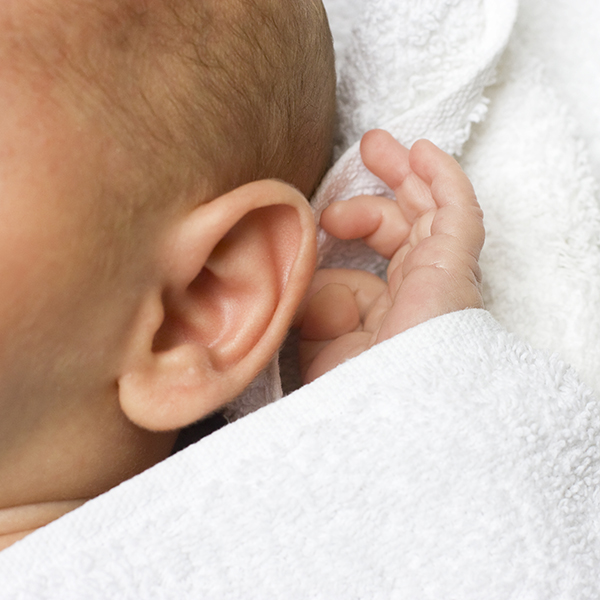We can’t overemphasize the importance of follow-up
If you’re having a baby, one of the flurry of tests you can expect for your newborn is a hearing test.
Happily for most parents, the test is no big deal—just one more check off the list to show that your baby is healthy and normal.
But what happens if your child fails the universal hearing test given at birth?
“That is certainly a red flag,” said Sarah King, an audiologist at Augusta University Health. “That’s when we need to obtain more information.”
In some cases, the answer could be a simple as fluid in the ears, which goes away soon after birth. But any baby who fails the newborn hearing test needs follow-up testing, just to make sure there’s not a bigger problem.
Statistics show that about 1 to 6 out of 1,000 newborns have some level of hearing loss at birth, which can be caused by the birth process, congenital abnormalities, genetics as well as medications or infectious diseases during pregnancy. Diagnosing hearing loss as soon as possible gives your child the best chance of developing speech and language skills on track with his or her peers.
Remember: 1, 3, 6
For babies with possible hearing loss, King suggests that parents remember the 1, 3, 6 rule:
- By 1 month, babies should be screened using the universal hearing test;
- By 3 months, they should be diagnosed through follow-up testing;
- At 6 months (right about the time they start to form words like mama and dada), they should have interventions (such as hearing aids and surgery)
“That’s the optimal protocol since by 6 months of age, children start to develop language, and hearing is an important component of that,” explained Dr. Mohammad Seyyedi, an otolaryngologic surgeon at Augusta University Health who cares for both adults and children.
At many hospitals, follow-up hearing testing involves an automated auditory brainstem response test. This simple test uses small cups over the ears and stickers (electrodes) on the neck and shoulder that can measure your child’s actual ability to hear, outside of any fluid or other physical issues. If your child fails that, an audiologist will conduct a regular auditory brainstem response test to further evaluate the hearing nerve to determine specifics of how your child hears in regard to pitch and volume.
If your child fails both ABRs, then it’s time to discuss possible interventions.
“Depending on the type and reason for hearing loss, your physician may suggest a treatment plan that can vary from ventilation tube placement and other procedures to hearing aids. In cases of severe hearing loss not aidable with hearing aids, cochlear implantation is an option,” said Dr. Seyyedi.
“In appropriate cases with sensorineural hearing loss, we want to fit the child with hearing aids as soon as possible,” said King. An audiologist will fit your child with the appropriate hearing aids, which should be worn during your child’s waking hours. (They can be worn while sleeping, but may be uncomfortable for your child.) Several appointments will be made following the hearing aid fitting to assess the progress of using the hearing aids. After at least three months of hearing aid use, your ENT and audiologist will evaluate your child’s hearing and language development again. If your child’s speech and language isn’t where it should be, your physician may suggest an evaluation for a cochlear implant.
The Facts on Cochlear Implants
A cochlear implant is a device that sends sound signals directly to the brain. It includes an external microphone, speech processor and transmitter, which appear similar to a hearing aid. The implant also includes internal components such as electrodes and a receiver that require day surgery.
But despite what all the internet videos show you of babies lighting up as soon as their cochlear implants are activated, parents should be cautious of anticipating a miraculous result from the start. “I compare it to a prosthetic leg,” said King. “You wouldn’t expect someone with a prosthesis to immediately be able to run a marathon; in the same way, learning to hear with a cochlear implant takes time.”
Your child will see his or her surgeon a week after surgery to check the incision site, but the implant itself will be turned on a month after surgery. Your child will then need to work with an audiologist and a speech therapist, along with completing exercises with you at home, on a regular basis. “The family is one of the most important factors in a child’s success,” said King.
Still, for children with profound hearing loss, the cochlear implant can be a life changer. For example, your child can attend a mainstream school instead of a deaf school. But as with any intervention, getting there early is key. “For babies with hearing loss, there’s a golden time when it’s ideal for them to get interventions, and that’s within the first two years of life,” said Dr. Seyyedi. “During these early years, sensory input is so very important for language development as well as for the development of function of the brain. For development of both hemispheres of the brain, cochlear implantation is recommended on both sides at the same time or at six-month intervals.”
“It’s heartbreaking when we don’t see a child who was diagnosed at birth until he or she is about to start school,” added King. “Those precious years can’t be regained. So we can’t emphasize enough the importance of 1, 3, 6: Have your child screened, get a diagnosis and get help within the first year of life.”




